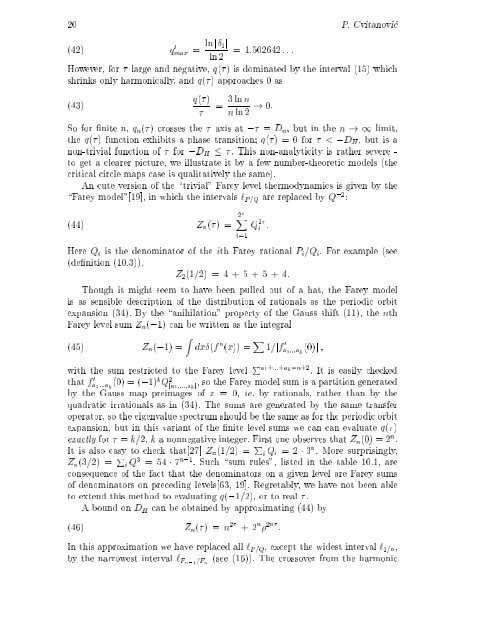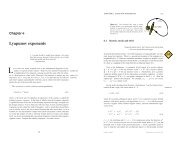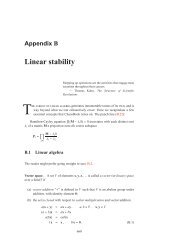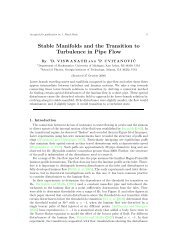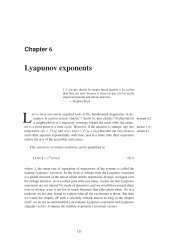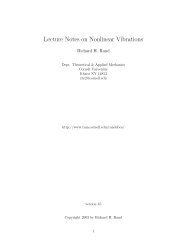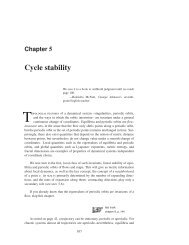10 Circle Maps: Irrationally Winding - Center for Nonlinear Science
10 Circle Maps: Irrationally Winding - Center for Nonlinear Science
10 Circle Maps: Irrationally Winding - Center for Nonlinear Science
Create successful ePaper yourself
Turn your PDF publications into a flip-book with our unique Google optimized e-Paper software.
20 P. Cvitanovic<br />
q 0 max = ln j 1j<br />
(42)<br />
= 1:502642 :::<br />
ln 2<br />
However, <strong>for</strong> large and negative, q() is dominated by the interval (15) which<br />
shrinks only harmonically, andq() approaches 0as<br />
(43)<br />
q()<br />
<br />
= 3lnn<br />
n ln 2 ! 0:<br />
So <strong>for</strong> nite n, q n () crosses the axis at ; = D n , but in the n ! 1 limit,<br />
the q() function exhibits a phase transition q() = 0 <strong>for</strong> < ;D H , but is a<br />
non-trivial function of <strong>for</strong> ;D H . This non-analyticity is rather severe -<br />
to get a clearer picture, we illustrate it by a few number-theoretic models (the<br />
critical circle maps case is qualitatively the same).<br />
An cute version of the \trivial" Farey level thermodynamics is given by the<br />
\Farey model"[19], in which the intervals `P=Q are replaced by Q ;2 :<br />
(44)<br />
Z n () =<br />
2 n X<br />
i=1<br />
Q 2<br />
i :<br />
Here Q i is the denominator of the ith Farey rational P i =Q i . For example (see<br />
(denition (<strong>10</strong>.3)),<br />
Z 2 (1=2) = 4 + 5 + 5 + 4:<br />
Though it might seem to have been pulled out of a hat, the Farey model<br />
is as sensible description of the distribution of rationals as the periodic orbit<br />
expansion (34). By the \anihilation" property of the Gauss shift (11), the nth<br />
Farey level sum Z n (;1) can be written as the integral<br />
(45)<br />
Z n (;1) =<br />
Z<br />
dx(f n (x)) = X 1=jf 0 a 1 :::a k<br />
(0)j <br />
with the sum restricted to the Farey level P a 1 +:::+a k =n+2<br />
. It is easily checked<br />
that fa 0 1 :::a k<br />
(0) = (;1) k Q 2 [a 1 :::a k ],sotheFarey model sum is a partition generated<br />
by the Gauss map preimages of x = 0, ie. by rationals, rather than by the<br />
quadratic irrationals as in (34). The sums are generated by the same transfer<br />
operator, so the eigenvalue spectrum should be the same as <strong>for</strong> the periodic orbit<br />
expansion, but in this variant of the nite level sums we can can evaluate q()<br />
exactly <strong>for</strong> = k=2, k a nonnegative integer. First one observes that Z n (0) = 2 n .<br />
It is also easy to check that[27] Z n (1=2) = P i Q i = 2 3 n . More surprisingly,<br />
Z n (3=2) = P i Q 3 = 54 7 n;1 . Such \sum rules", listed in the table <strong>10</strong>.1, are<br />
consequence of the fact that the denominators on a given level are Farey sums<br />
of denominators on preceding levels[63, 19]. Regretably, we have not been able<br />
to extend this method to evaluating q(;1=2), or to real .<br />
A bound on D H can be obtained by approximating (44) by<br />
(46)<br />
Z n () = n 2 + 2 n 2n :<br />
In this approximation we have replaced all `P=Q , except the widest interval `1=n ,<br />
by the narrowest interval `Fn;1=F n<br />
(see (16)). The crossover from the harmonic


